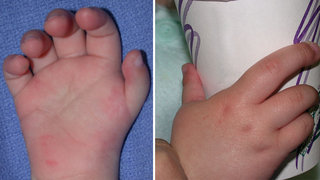What is thumb hypoplasia?
Thumb hypoplasia is the medical term for missing or underdeveloped thumbs. Thumb hypoplasia is a congenital difference, which means your child is born with this condition.

The degree to which your child’s thumb is underdeveloped can vary; it may only be slightly smaller in size than normal, or missing entirely (a condition known as thumb aplasia).
Thumb hypoplasia is a rare condition and occurs in about 1 in 100,000 infants. It is equally common in males and females. In approximately 60 percent of patients with thumb hypoplasia, both thumbs are affected. In some cases, a child’s other fingers may also be missing or underdeveloped.
Causes
The cause of thumb hypoplasia is unknown, but the condition has been associated with several genetic syndromes and conditions including:
- VATER syndrome, a group of birth defects that affect five different areas in which a child may have abnormalities: vertebrae, anus, trachea, esophagus and renal (kidneys)
- TAR syndrome, which is characterized by the absence of the radius bone in the forearm and extremely reduced platelet count
- Holt-Oram syndrome, often called hand-heart syndrome, which includes abnormalities of hands and arms, as well as cardiac defects
- Fanconi’s anemia, which is a rare blood disorder that affects many parts of the body
Testing and diagnosis
In most cases, thumb hypoplasia is identified after birth. In some cases, the condition is diagnosed before birth during an ultrasound.
In order to determine the best course of treatment for your child, doctors at Children’s Hospital of Philadelphia (CHOP) may:

- Conduct a thorough physical exam of your child and take a family medical history
- Use imaging techniques like X-rays to look at the underlying structure of your child’s hands
- Recommend genetic testing and imaging of other parts of the body to identify related genetic syndromes and conditions
- Recommend a cardiac echocardiogram if a heart murmur is detected
- Recommend a renal ultrasound if a genetic anomaly is suspected
Treatment
The thumb is a very important part of the hand: it accounts for about 40 percent of the hand’s function. This is why surgery to reconstruct a small thumb or create a thumb if one is missing entirely is usually the recommended treatment for thumb hypoplasia.
Your child will be examined by one of our pediatric hand and arm specialists to determine which surgery is best suited to her condition.
Reconstruction
If your child’s hand has a carpometacarpal joint, which stabilizes the base of the thumb, your child may benefit from a surgery to rebuild the ligaments and fix the tendons of the thumb. This will allow the reconstructed thumb to function more normally.
Thumb reconstruction is typically performed as an outpatient procedure when your child is about a year old. Your child will go home the same day as the procedure. She will have a long arm cast for two weeks after surgery, then be in a splint for another two weeks. She may need to work with one of our hand therapists to maximize functionality of the reconstructed thumb.
Pollicization
If your child does not have a carpometacarpal joint, a surgeon will perform a pollicization. This surgery includes the amputation of the non-functional, unstable thumb and the construction of a useable thumb by moving the index finger to the thumb position.


This procedure is typically performed as an inpatient procedure when your child is about a year old. Your child will be spend one night in the hospital after this surgery and will be in a long arm cast for two weeks following the surgery.
After the cast is removed, your child’s hand will be placed in a splint and hand therapy will be started. In most cases, your child will need several months of hand therapy after surgery. The newly constructed thumb will never be as strong or have as much range of motion as a normal thumb, but this surgery will significantly increase the functionality of your child’s hand.
Pollicization may be followed by subsequent procedures to deepen the web space between the fingers or improve motion.
Follow-up care
Your child will need to be examined by the hand surgeon two weeks after surgery, and again at six weeks and three months postoperatively.
Your child will need hand therapy after surgery. The duration of therapy will depend on which surgery was performed and how much normal hand function your child has.
You can also expect to return to the hand surgeon for several annual visits throughout early childhood to ensure that your child is developing appropriate hand function as she develops skills such as writing and playing sports.
Resources to help
Thumb Hypoplasia Resources
Hand and Arm Disorders Program Resources
We have compiled resources to help you find answers to your questions and feel confident with the care you are providing your child.

